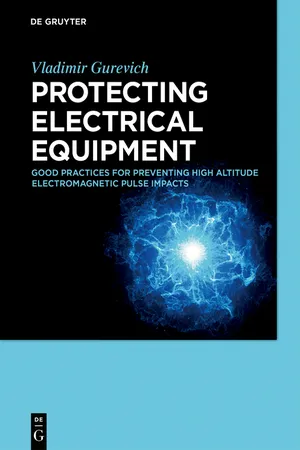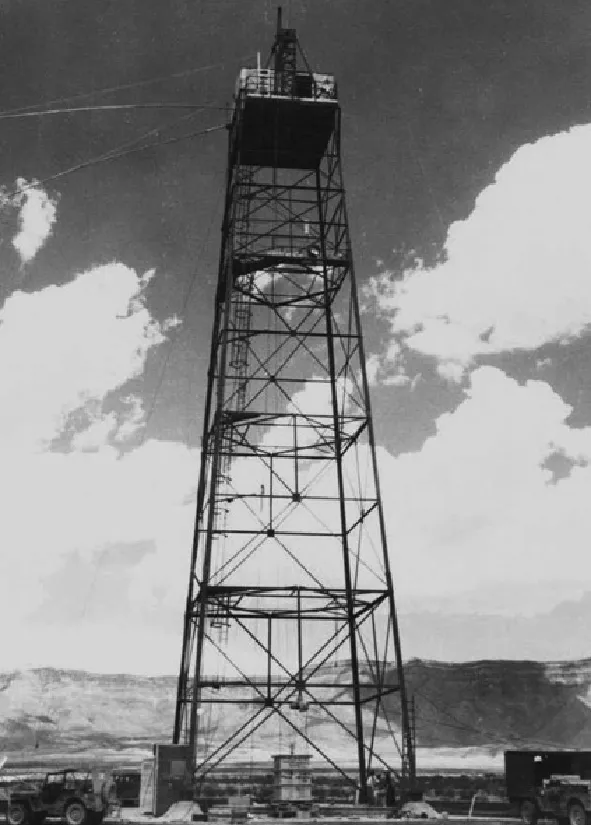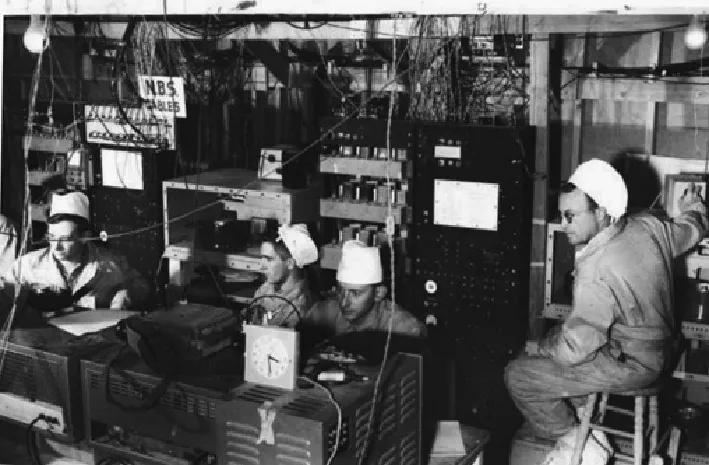
eBook - ePub
Protecting Electrical Equipment
Good practices for preventing high altitude electromagnetic pulse impacts
- 404 pages
- English
- ePUB (mobile friendly)
- Available on iOS & Android
eBook - ePub
Protecting Electrical Equipment
Good practices for preventing high altitude electromagnetic pulse impacts
About this book
How do you protect electrical systems from high energy electromagnetic pulses? This book is designed for researchers who wish to design toughned systems against EMPs from high altitude sources. It discusses numerous factors affectíng the strength of EMPs as well as their impact on electronic components, devices and power electrical equipment. This book includes practical protection methods and means for evaluating their effectiveness.
Frequently asked questions
Yes, you can cancel anytime from the Subscription tab in your account settings on the Perlego website. Your subscription will stay active until the end of your current billing period. Learn how to cancel your subscription.
At the moment all of our mobile-responsive ePub books are available to download via the app. Most of our PDFs are also available to download and we're working on making the final remaining ones downloadable now. Learn more here.
Perlego offers two plans: Essential and Complete
- Essential is ideal for learners and professionals who enjoy exploring a wide range of subjects. Access the Essential Library with 800,000+ trusted titles and best-sellers across business, personal growth, and the humanities. Includes unlimited reading time and Standard Read Aloud voice.
- Complete: Perfect for advanced learners and researchers needing full, unrestricted access. Unlock 1.4M+ books across hundreds of subjects, including academic and specialized titles. The Complete Plan also includes advanced features like Premium Read Aloud and Research Assistant.
We are an online textbook subscription service, where you can get access to an entire online library for less than the price of a single book per month. With over 1 million books across 1000+ topics, we’ve got you covered! Learn more here.
Look out for the read-aloud symbol on your next book to see if you can listen to it. The read-aloud tool reads text aloud for you, highlighting the text as it is being read. You can pause it, speed it up and slow it down. Learn more here.
Yes! You can use the Perlego app on both iOS or Android devices to read anytime, anywhere — even offline. Perfect for commutes or when you’re on the go.
Please note we cannot support devices running on iOS 13 and Android 7 or earlier. Learn more about using the app.
Please note we cannot support devices running on iOS 13 and Android 7 or earlier. Learn more about using the app.
Yes, you can access Protecting Electrical Equipment by Vladimir Gurevich in PDF and/or ePUB format, as well as other popular books in Physical Sciences & Electromagnetism. We have over one million books available in our catalogue for you to explore.
Information
1 Electromagnetic pulse—a parcel from the past
1.1 Introduction
High-Altitude Electromagnetic Pulse (HEMP) addressed in this book is one of the damaging effects of nuclear explosions, more specifically, high-altitude nuclear explosion, when the nuclear weapon explodes at the altitude of 30–400 km, i. e., in the ionosphere or even in near space (The International Aeronautical Federation has set the altitude of 100 km (a so-called Karman line) as the borderline between the atmosphere and space). Obviously, explosions occurring at this altitude cannot result in serious terrestrial destruction or people’s death. So why would somebody use it as an effective tool of war? Effecting what? Why do people talk about it 70 years after the first trial of the nuclear weapon? Let us try to answer these questions and in order to do it, we shall need to begin with the history of HEMP discovery.
1.2 History of HEMP
The history of HEMP originates from the moment of the first test of a nuclear weapon.




Unlike other correlative physical phenomena, it was not predicted in advance. It was rather discovered “with the point of the pen”. Furthermore, HEMP was not immediately understood and explained upon its discovery, and conclusions drawn from some subsequent proposed theories turned out to be erroneous.
The first nuclear test explosion was performed within the frameworks of the famous ‘Manhattan project’ in USA at the Alamogordo range, 200 miles south from Los Alamos (New Mexico) on July 16, 1945. The 20 kt explosive (informally called “gadget”), made of Pu-239 (Figures 1.1 and 1.2), was mounted on a 33-meter steel tower (Figure 1.3), while the administration and data collection center (Figure 1.4) was located at a safe distance inside a protected building.
The word “Trinity” derives from the Latin word “trinitas”. This concept is used in Christian religion to denominate the triality of the Lord: the Father, the Son and the Holy Spirit. Thus, Robert Oppenheimer, (Figure 1.6) the research advisor for the project and the manager of Los Alamos laboratory, gave this name to the project under the influence of the religious poetry of John Donne (English poet of the 17th century).
Simultaneously, the Conference of the Three Heads of Government was held in Potsdam. Upon receiving an encrypted notice with a coded phrase “Delivery was successful”, the US President Harry S. Truman suddenly saw himself as the ‘Ruler of the World’ and informed Joseph Stalin that the USA had invented a new type of weapon. The reason for such openness was clear: it was the USA’s habit to hold negotiations “from a position of strength”. However, this message did not surprise Joseph Stalin as much as Truman may have expected. Truman could hardly imagine that Stalin had known that the Americans were preparing and rushing to test the first nuclear bomb, so he took corresponding measures.



In 1946, after the test, the Los Alamos laboratory issued a secret report LA-1012, which remained classified for more than 30 years. It was not until May 1976 that a declassified version of this report (LA-6300-Y, Figure 1.5) was issued, even though some data were deleted. Yet, the initial and general information about HEMP was published in the released version of the report. This information was published in Section 1.7 (Figure 1.5) and consisted of only several lines. This section suggested that the problems with sensor-signal transfer has been anticipated based on the theory of Enrico Fermi. Fermi determined that a nuclear explosion created X-ray emission, leading to ionization of the air over a large area and resulting in a high difference of potentials in the atmosphere (similar to lightning discharges). That is why all signal cables were thoroughly shielded and buried in the ground. However, despite all preventive measures, many types of data-acquisition equipment were knocked out of service during the explosion by a high-voltage pulse. It should be noted that electronic equipment of that time was made of vacuum tubes (Figure 1.4), i. e., it was rather primitive, unsophisticated and far less sensitive compared to modern micro-processor-based measuring equipment.
This was the first-ever registered impact of EMP on electronic equipment.
Further missions (Crossroads, Sandstone, Greenhouse, Buster-Jangle, Tumbler-Snapper, Ivy, Upshot-Knothole, Castle, Teapot, Wigwam and Redwing) involved a series of explosions and enabled research on various aspects of ground-surface, above-water and underwater nuclear explosions, including the measurement of EMP. Upon explosion, the data-acquisition equipment was frequently knocked out of service, and so many parameters of the explosion remained unrecorded. This was attributed to the inferiority of equipment and their low reliability.
Similar cases of equipment damage by a powerful electromagnetic-pulse field were registered during nuclear weapon testing conducted by Great Britain in 1952–1953 (Maralinga range, South Australia). British physicists called this phenomenon “radio-flash”. A concept similar to what we call electromagnetic pulse today was also used in some early publications of Soviet scientists.
In 1958, US scientists and military experts resumed EMP research within the Hardtack-1 mission, which involved 35 nuclear explosions of various types. Some of those explosions were high-altitude explosions. The first high-altitude nuclear explosion in the US (Yucca project, Figure 1.7) was performed using a large stratospheric balloon, launched from the Essex aircraft carrier (USS Boxer CVS-21), see Figure 1.8. It was a relatively low-capacity (1.7 kt) explosive weighing about 100 kg. In addition to the explosive, the air-balloon carried containers with data-acquisition equipment attached to it on a long rope. The total weight of equipment carried by the air-balloon was 346 kg. The explosive was detonated 26 km above ground between Eniwetok and Bikini atolls on April 28, 1958. This explosion was expected to offer possibilities of using nuclear explosive as a means capable of impacting missile and air-defense electronic systems.
In addition to data-acquisition equipment placed in five evenly spaced containers under the nuclear explosive (suspended on the same rope), a US Army research laboratory also registered HEMP parameters from two tracking stations located in the towns of Wotho and Kusale (100 and 460 miles from Bikini, respectively). Moreover, two long-range B-36 bombers equipped with data-acquisition equipment remained in the air at a safe distance from the point of explosion. Initially, the plan was to launch the balloon from the ground. However, since even a light breeze could significantly impact such a large air-balloon, a decision was made to relocate the launch to a ship. In order to avoid any shift of the balloon and its ballast at the time of launching, the ship was supposed to move in the windward direction at the wind’s speed. During the preparation stage, a total of 76 air-balloons with ballast dummies were launched from various locations.
The Hardtack mission involved two additional high-capacity, high-altitude nuclear explosions coded “Teak” and “Orange”. For the purpose of the “Teak” project, the thermonuclear explosive W-39 (3.8 Mt) was delivered to the altitude of 77 km by a Redstone missile (Figure 1.9), which was launched from one of Johnson Atoll’s islands on July 31, 1958. The outcome of this nuclear explosion was a powerful EMP, which could not be recorded in the testing area due to the failure of data-acquisition equipment, errors in preliminary calculations and predictions made by Hans Bethe (the famous theoretical physicist) regarding EMP.


Nonetheless, a powerful geomagnetic storm, much stronger than geomagnetic agitations caused by magnetic storms on the Sun, and some flashes in the sky were registered far away from the explosion epicenter in the observatory of Apia town (Upolu island in the Pacific Ocean)—the capital of Samoa, located 3,200 km from Johnson Atoll.

During the “Orange” project, (August 11, 1958), a nuclear explosive of the same type was delivered by the same missile from the same range, but to an altitude of 43 km. Unfortunately, the search for any additional data regarding the EMP effect in this project in published or declassified literature was unsuccessful. Some authors have claimed recurring problems with data-acquisition equipment, whereas others have suggested that information about this project is still classified. However, fragmentary data published in partially declassified (1999), to be more precise, “sanitized” (“sanitized version” is what is written on the front page), report ITR-1660 regarding Hardtack-1 in 1959 (Figure 1.10), suggest that many registered EMP parameters appeared to be different from what was exp...
Table of contents
- Cover
- Title Page
- Copyright
- About the Author
- Annotation
- Introduction
- Contents
- 1 Electromagnetic pulse—a parcel from the past
- 2 A contemporary view of HEMP for electrical engineers
- 3 HEMP simulators
- 4 The vulnerability of electronic equipment to HEMP
- 5 Electronic components for HEMP protection system
- 6 External protection of power systems’ electronic equipment from HEMP
- 7 The issues of electronic equipment grounding at the power facilities
- 8 The issue of control cables selection for HEMP-protected electric facilities
- 9 Grounding of control-cable shields
- 10 HEMP filters
- 11 High-voltage insulation interfaces
- 12 Improvement of the resilience of industrial cabinet-installed electronic equipment to HEMP Impact
- 13 Basic principles of direct-current auxiliary-power system (DCAPS) protection
- 14 Protection of telecommunication systems in electric power facilities from HEMP
- 15 Improvement of HEMP resilience of automatic fire-suppression systems
- 16 Protection of diesel generators from HEMP
- 17 Features of HEMP resilience-test methods for power system electronics
- 18 Methods and means of evaluation of the effectiveness of HEMP protection of the installed power-system
- 19 Features of testing digital protective relays resilience to HEMP
- 20 Establishment of inventory of electronic equipment’s replacement modules as a way to improve survivability of the power system
- 21 The problem of impact of geomagnetically induced currents on power transformers and it solution
- A Standards on HEMP
- Index